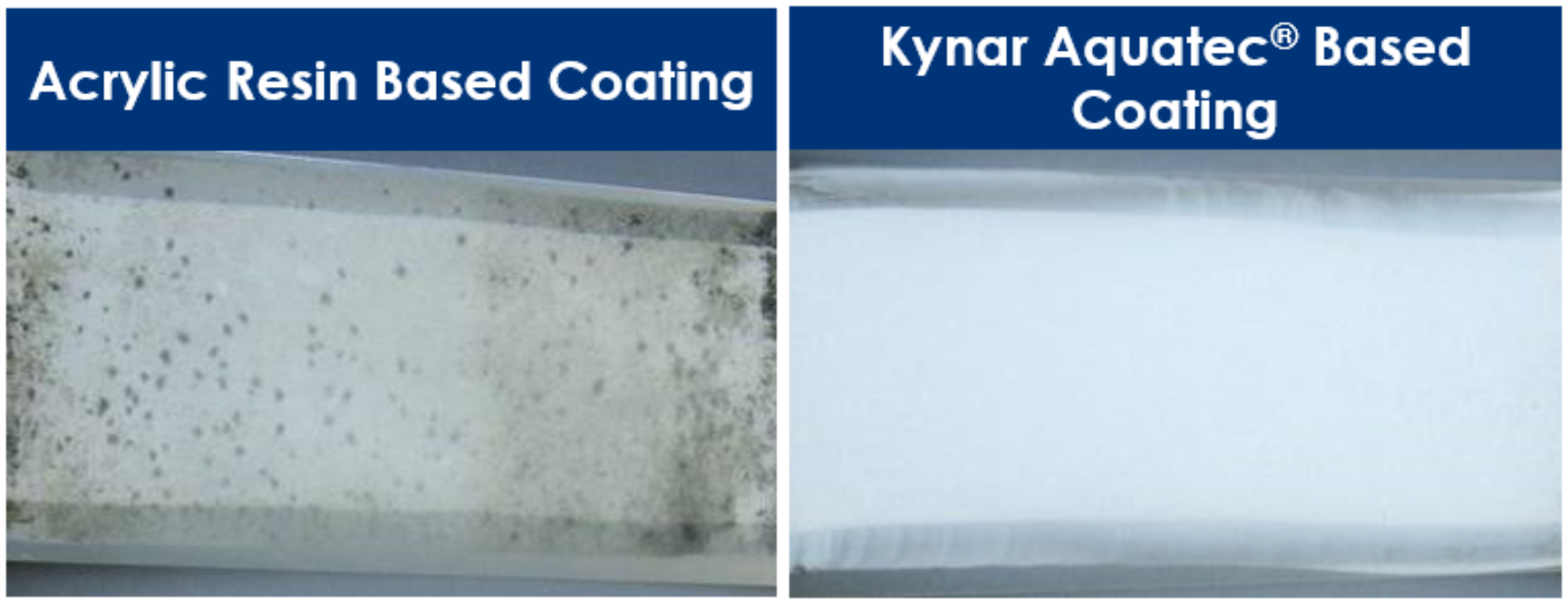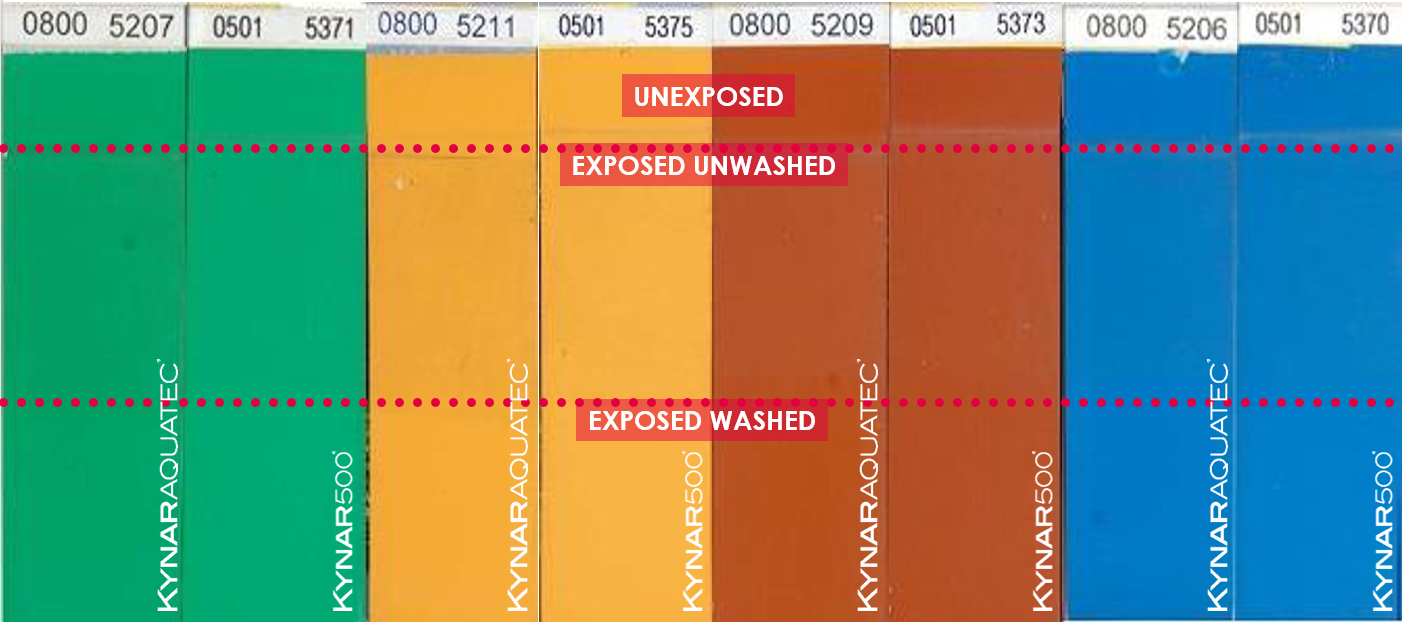Lower your Lifetime
Ownership Cost
with a Kynar Aquatec® PVDF
Coated Roof!
Increase your Project's Return on Investment (ROI) by ensuring a long life with ultra low maintenance and reduced energy costs. Maintain the curb appeal of your property!
Reduce the Lifetime cost of your Roof or Facade
Many favorable attributes combine to provide a Lower Lifetime Ownership Cost:
- Lower Energy Usage from Higher Solar Reflectivity and Lower Roof Temperatures
- Lower Carbon Footprint
- Reduced Dirt pick-up
- Mold & Mildew resistance
- World-class UV Resistance and Long-Life Color Retention
- Lower Peak Energy Demand Charge
- Longer Lifespan of Roof Coating and Longer Lifespan of Roof Substrate
- Lower Maintenance Costs & Less Downtime
- Increased Efficency and Longer Lifespan of HVAC Equipment
- Lower VOC Emissions
- Tax Credits, Rebates, and Building Codes
- Green Building Credits
- Cool Roof can be applied for a wide variety of roofing types
Lower Energy Usage from Higher Solar Reflectivity and Lower Roof Temperatures
Higher Reflectivity (TSR value) throughout the roof's life results in lower cooling costs.
A properly-formulated Kynar Aquatec® PVDF coating can significantly reduce the surface temperature by reflecting the Sun's rays. For roofs, it has been shown to reduce the roof's surface temperature by as much as 50°F (28°C)[1] , and interior temperatures by 6-9°F (3-5°C)[2], which translates into reducing cooling costs by as much as 30%[3].
Furthermore, Kynar Aquatec® PVDF resin-based roof coatings have shown the ability to maintain a 3-year Total Solar Reflectance (TSR) above 0.80[4], well above industry standards for white roofs of 0.55 (as measured by the Cool Roof Rating Council)[5]. This means a roof with a Kynar Aquatec® PVDF topcoat can reflect over 80% of the suns' rays. By comparison, a Modified Bitumen or Asphalt Shingle has has a TSR of only 0.05 - 0.25[6].
Kynar Aquatec® PVDF-based coatings can reduce the "Heat Island Effect" of cities, where the difference between outside air temperatures in a city and its surrounding rural areas can be 5 - 9°C higher (9 -16°F)[7].
Lower Carbon Footprint
Reduced air conditioning means less energy used, less Carbon Dioxide emitted, and more comfortable building conditions.
Lower energy bills means less fossil fuels needed to generate electricity and so a lower Carbon Footprint. Add in less frequent roof cleanings and recoatings, and the Carbon Footprint of your project shrinks even further.
Reduced Dirt Pick-up
A Kynar Aquatec® PVDF topcoat's low surface energy promotes dirt shedding.
The surface of Kynar Aquatec® PVDF-formulated coatings reduces dirt pick-up, keeping your project brighter and fresher looking. The pictures below show the results when a 1" square area of carbon black is applied to the paint surface and then is washed off. You can clearly see that the surface of the Kynar Aquatec® PVDF-based coating is much easier to clean than the surface of the acrylic based coating.

Mold & Mildew Resistant
A Kynar Aquatec® PVDF topcoat is inherently Mold & Mildew resistant.
Kynar Aquatec® PVDF resin helps to prevent Mold and Mildew growth. In the example below, the Kynar Aquatec® PVDF coating stayed clean vs. the acrylic based coating after 19 months weathering in South Florida. No biocide was added to either coating.

World-class UV Resistance and Long-Life Color Retention
Whether you select highly-reflective White or a reflective-pigment Colored roof, you'll have Industry-leading Color Retention backed by 50 yrs of weathering data.
Kynar 500® PVDF resin is synonymous for long-lasting Color Retention. Kynar 500® PVDF resin-based coatings have been used on notable buildings since 1965. Using the same PVDF technology, Kynar Aquatec® PVDF resin-based coatings have exhibited the same color fast performance. This picture shows the color fastness after over 20 years of weathering in South Florida.

Lower Peak Energy Demand Charges
Commercial Buildings are often charged Peak Demand fees by local utilities.
Peak Demand fees are a significant cost for commercial buildings, often greather than the electricity usage fees themselves. A 20 - 30% reduction in Peak Demand fees is common for Cool White Roofs.[9]

Longer Lifespan of Roof Coating and Longer Lifespan of Roof Substrate
Kynar Aquatec® PVDF resin-based roof coatings commonly last 20 yrs. or more, much longer than the typical lifespan of an acrylic coating. Plus the roofing substrate lasts longer due to lower heat history.
The ability for a Kynar Aquatec® coating's PVDF backbone to withstand the Sun's UV ray is unbeaten. This results in a longer-lasting roof coating. A lifespan of 20 years for Kynar Aquatec® PVDF-based roof and façade coatings are quite common, well outpacing the lifespan of acrylic coatings which as low as 7 years. Additionally, the cooler surface temperature (by as much as 50°F/28°C) results in less degradation of the roofing substrate, extending the lifespan of the substrate.
Lower Maintenance Costs & Less Downtime
Less frequent roof cleanings, means lower expense, and less downtime.
The reduced Dirt Pick-up, combined with the Mold & Mildew resistance from Kynar Aquatec® PVDF coatings, results in a cleaner roof. As a result, significantly less frequent washing required. The longer lifespan and decreased maintenance also means less disruption to the building occupants and less downtime for the building. Other coating options may require more frequent washings in order to keep the warranty valid.
Increased Efficency and Longer Lifespan of HVAC Equipment
A cooler roof means less A/C use…and also means your existing equipment is more effective, extending the lifespan of your A/C unit. Alternatively, a smaller, less-expensive A/C unit could be adequate.
The cooler surface temperature (by as much as 50°F/28°C) of a Kynar Aquatec® PVDF resin-based roof coating results in several benefits: (1) less use and less wear & tear on the HVAC equipment, translating into longer service life for the equipment, (2) higher efficiency of rooftop units (due to lower inlet temperatures to rooftop air units)[10], and (3) for new construction, a small HVAC unit could be specified reducing the upfront HVAC investment.
Lower VOC Emissions
Kynar Aquatec® PVDF coatings are formulated to be low VOC. PLUS the Kynar Aquatec® PVDF coating's long lifespan means less recoating (and less VOC's emitted during the recoating process).
Each time you recoat, volatile organic compounds (VOC's) are emitted into the atmosphere. Kynar Aquatec® PVDF resin is typically formulated into low VOC coating formulations. Additionally, since Kynar Aquatec® PVDF-based coatings have a much longer lifespan than traditional acrylic coatings, there are less frequent recoatings, which means less VOC's emitted into the atmosphere over the roof's lifespan. In fact, a Study by Lawerence Berkeley National Laboratory showed a 30-40% reduction in VOC emssions.[6]
Tax Credits, Rebates, and Building Codes
In many situations, Cool roof coatings may be treated as a current year expense, reducing tax liability. Other rebates and credits may be available in your region. Some regions have added cool roof requirements or incentives to their building codes, including ASHRAE 90.1.
Tax Benefit: Cool coatings are typically classified as maintenance, and in many cases, can be written off in the year they are installed, rather than capitalized over 39 years like traditional roof materials.[12][13]
Rebates: Government-sponsored incentives or rebates may help offset the cost of your project. See https://www.roofcoatings.org/membership-benefits/ for more information.
Codes: ASHRAE 90.1 Solar Reflectance Requirement (5.5.3.1.1 ), California Title 24 (Section 140.3 and others) aged solar reflectance at least 0.63 for many applications[14]. Also, Texas, Georgia, Florida, Alabama, Hawaii, Los Angeles, Chicago, New York City, Philadelphia, Austin, Dallas, Denver, Houston and Washington, D.C., have all implementehave cool roof included in their building codes. For more information, visit https://coolroofs.org/resources/rebates-and-codes
Green Building Credits
Earn two LEED® v4 credits for Sustainable Sites credit for Heat Island reduction.
For Low-Sloped Roofs, use materials with initial Solar Reflectance above 0.82 and a 3-year aged SRI above 0.64 to receive two points. Cool Roofs can also help toward other LEED® credits[15]. See also https://coolroofs.org/resources/leed. Alternatively, ASHRAE 90.1 allows for decreased roofing insulation where Cool Roof coatings are employed.
Kynar Aquatec® PVDF Resin-Based Cool Roof coatings can be applied for a wide variety of roofing types
Available for Metal, Concrete, Modified Bitumen, Membrane (EPDM, TPO, PVC), or Tile
Kynar Aquatec® PVDF resin-based coatings can be field-applied via spray, brush, or roll, with an ambient cure. They also can be factory-applied.
Cool Roofs are one of the fastest and least expensive ways to slow global warming
Cool Roof Coating with Kynar Aquatec® PVDF Experiment
References
- https://www.energy.gov/energysaver/energy-efficient-home-design/cool-roofs
- https://www.roofcoatings.org/reflective-roof-coatings-institute/for-building-owners-and-facility-managers/
- "Cool Roofs for Hot Projects", by Sherry Hao, Jessica Clark, LEED AP, Cleste Allen Novak, AIA, LEEK AP, Sara Van Mantgem. Cool Roof Rating Council. Need more citiation info.
- Las Vegas, NV Commercial Building - -Arkema study of TSR of a 10 year-old Kynar Aquatec® based roof coating. https://www.kynaraquatec.com/en/media/case-studies/mgm-grand/
- https://coolroofs.org/documents/CoolRoofsforHotProjects.pdf
- coolmetalroofing.org: Cool Metal Roofing, An Emerging Hot Topic Case Study, May 2015.
- A Practical Guide to Cool Roofs, www.coolrooftoolkit.org, page 8.
- A cleaning regimen to retain initial solar reflectance of 0.70 has been shown to increase the net energy savings by over 40%, which equated to $0.5 to $3/m2 in one study. Levinson, R., Berdahl, P., Asefawberhe, A., & Akbari, H. (2005). Effects of soiling and leaning on the reflectance and solar heat gain of a light-colored roofing membrane. Atmospheric Environment, 39(40), 7807–7824.
- “Reducing Peak Electrical Demand with Reflective Roofs” Jim Hoff, TEGNOS Research, Inc. and Andre Desjarlais, Oak Ridge National Laboratory (ORNL), 2016.
- Haverstic, P. A Case Study on the Impact of Solar Reflectance Attenuation and Roof Cleaning on a Cool Roof Return on Investment, Arizona State University, Dec. 2016. Page. 4
- Derived from a study published by Lawrence Berkeley National Laboratory on energy savings and greenhouse gas reduction. The T.S.R. value of 0.77 are three-year test data certified by the Cool Roof Rating Council. Based on a 20-year life cycle test conducted in California by Arkema Inc., roof=300 squares. TSR of Kynar Aquatec® =0.77 and TSR of Elastomeric Acrylic =0.55. Results will vary by location and climate type.
- "Coatings are considered “restoration” and not a new roof system installation. Therefore they may usually be expensed in the fiscal year during which they are applied instead of amortizing the cost over the life of the roof (as in a new membrane installation). This can be a huge tax benefit to some building owners. Check with your CPA or CFO to properly apply this information to your own roof situation." https://www.roofcoatings.org/reflective-roof-coatings-institute/for-building-owners-and-facility-managers/
- https://www.irs.gov/newsroom/new-rules-and-limitations-for-depreciation-and-expensing-under-the-tax-cuts-and-jobs-act
- https://ww2.energy.ca.gov/2018publications/CEC-400-2018-020/CEC-400-2018-020-CMF.pdf;
- "REFLECTIVE ROOF COATINGS AND LEED V4" , Roof Coatings Manufacturers Association, Nov. 2015.
LEED® is a registered trademark of the US Green Building Council.
